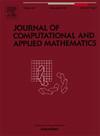New characterizations of the diamond partial order
IF 2.6
2区 数学
Q1 MATHEMATICS, APPLIED
Journal of Computational and Applied Mathematics
Pub Date : 2025-09-24
DOI:10.1016/j.cam.2025.117087
引用次数: 0
Abstract
Baksalary and Hauke introduced the diamond partial order in 1990, which we revisit in this paper. This order was defined on the set of rectangular matrices and is the same as the star and minus partial orders for partial isometries. New ways of describing and studying the diamond partial order are being looked into in this paper. Particularly, we present a new characterization by using an additivity property of the column spaces. Additionally, we also study the relationship between the left (resp., right) star and diamond partial orders. Specifically, we obtain conditions in which the diamond partial order means the left (resp., right) star partial order. The reverse order law for the Moore–Penrose inverse is characterized when is below under the diamond partial order. Finally, an interesting way of describing bi-dagger matrices is found. We also provide an algorithm to construct two rectangular matrices that are ordered under the diamond partial order. Numerical examples are given in order to confirm our results.
菱形偏序的新特征
Baksalary和Hauke在1990年引入了菱形偏序,本文对其进行了回顾。这个阶是在矩形矩阵的集合上定义的,与部分等距的星号和负偏阶相同。本文探讨了描述和研究钻石偏序的新方法。特别地,我们利用列空间的可加性给出了一个新的表征。此外,我们还研究了左(左)响应之间的关系。(右)星形和菱形偏序。具体地说,我们得到了菱形偏序意味着左响应的条件。(右)*偏序。在菱形偏序下,当A小于B时,给出了Moore-Penrose逆的逆序规律。最后,找到了一种描述双匕首矩阵的有趣方法。我们还提供了一种算法来构造两个在菱形偏序下有序的矩形矩阵。最后给出了数值算例,以验证本文的研究结果。
本文章由计算机程序翻译,如有差异,请以英文原文为准。
求助全文
约1分钟内获得全文
求助全文
来源期刊
CiteScore
5.40
自引率
4.20%
发文量
437
审稿时长
3.0 months
期刊介绍:
The Journal of Computational and Applied Mathematics publishes original papers of high scientific value in all areas of computational and applied mathematics. The main interest of the Journal is in papers that describe and analyze new computational techniques for solving scientific or engineering problems. Also the improved analysis, including the effectiveness and applicability, of existing methods and algorithms is of importance. The computational efficiency (e.g. the convergence, stability, accuracy, ...) should be proved and illustrated by nontrivial numerical examples. Papers describing only variants of existing methods, without adding significant new computational properties are not of interest.
The audience consists of: applied mathematicians, numerical analysts, computational scientists and engineers.

 求助内容:
求助内容: 应助结果提醒方式:
应助结果提醒方式:


